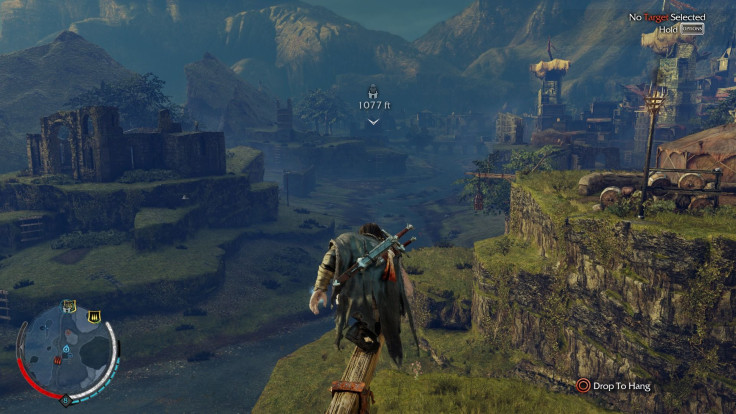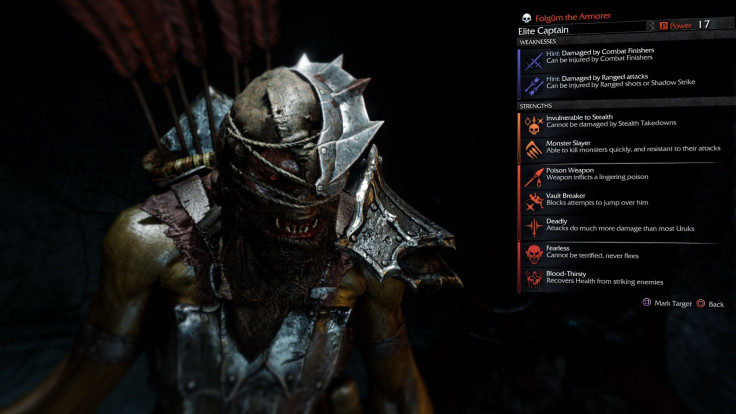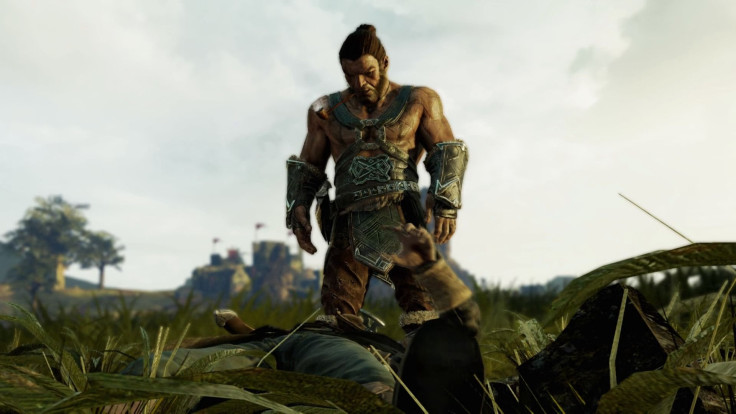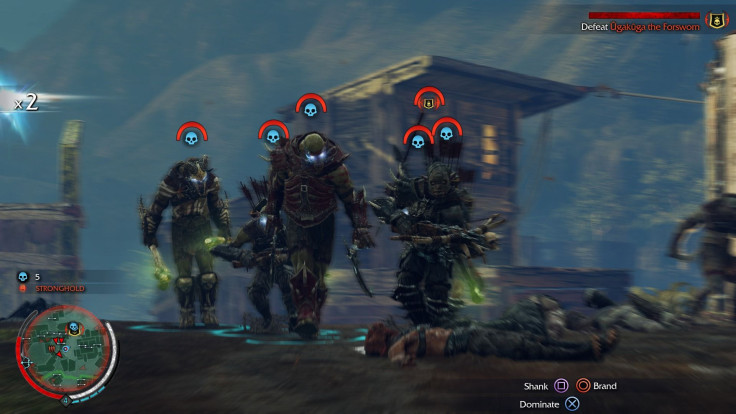“Man-swine!”
The Uruk captain’s voice boomed across the plains, freezing his followers in their tracks and giving him a clear path to begin his assault. The camera stops a few feet away, offering a close look at the blood-smeared face of Uggu Bone-Licker and the massive axes he's clutching in each hand. The time for words is over. Battle begins.
In the press of a button a ghostly outline, the Wraith, surrounds me. Time slows just enough to sink an arrow between Bone-Licker's eyes. An “invulnerable to ranged” message flashes across my screen, the first I’d seen in my half hour with the game, and panic shoots through my veins. Now what?
I’m surrounded by Uruk-hai fighters, barely familiar with the combat system and facing what looks to be a significantly better-equipped captain. Worse, because I stumbled upon Bone-Licker in the middle of nowhere, I don't have any intel on the Uruk and therefore don’t know his weaknesses. So, I run.
And Uggu follows.
With about a dozen snarling followers keeping a quick pace behind him.
****
Middle-earth: Shadow of Mordor thrusts players into one of the bleakest open-world environments I’ve ever encountered – seen through the eyes of a man cursed with eternal separation from his wife and child – and asks what steps you’ll take to give the former Ranger, Talion, a shot at salvation. Revenge may or may not be on the table, too.
Along the way, Monolith introduces a few new characters to Middle-earth, and even finds ways to incorporate iconic figures Lord of the Rings fans are already familiar with. Gollum makes a couple of appearances during your journey, along with another familiar character I’ll let you discover for yourself. As for the placement, Monolith carves out its own slice of time for a story occurring between the events of The Hobbit and those in the Lord of the Rings trilogy.
After completing the game’s brief (and heartbreaking) tutorial, it’s off to Mordor; a land I’m finding quite a bit more vibrant and colorful than I remember it from the Lord of the Rings books/films. Sure, it's still a muddy, barren wreck around the Black Gate, but there are some still surprisingly green areas in Mordor to explore. From this point, where you go and what you do is pretty much up to you and you alone.

You’ll need to complete a total of 20 story missions before seeing the credits roll on Middle-earth: Shadow of Mordor, but there are plenty of ways to put off tackling the game’s primary story content if you’re looking to get the most of your Middle-earth experience. That includes 10 missions each (for a total of 30) to help you improve your skills with Talion’s sword, dagger and bow, not to mention two-dozen rescue missions and an unlimited number of events involving the captains from Sauron’s army
There are also more than six dozen collectibles to be found in the game, split into two categories, and a handful of Forge Towers serving as the Fast Travel and respawn locations found in any modern open-world video game. And if all that isn't enough, you'll be happy to know Middle-earth: Shadow of Mordor also includes a series of Hunting and Survivalist challenges focusing on the skills a Ranger would need to survive on his/her own in the Uruks' homeland.
Middle-earth: Shadow of Mordor strips away the extraneous features littering the maps of lesser open-world projects, offering just enough content to give you a regularly rotating selection of activities as you stab, slice and otherwise dispatch of Mordor's inhabitants.
Along the way, you'll use three different rewards to improve Talion's abilities and unlock new skills to use in your fight against Sauron: experience, power rankings and a currency known as Mirian. Of course, none of this matters when you first start the game and you’re basically running for your life.
****
With more than a dozen orcs bearing down on me, not to mention the most intimidating captain I'd encountered, I wasn’t really sure what to do. I had no idea if aggro had been incorporated into Middle-earth: Shadow of Mordor or how far I'd have to run to break it. There was no back-up plan.
In many ways, it wouldn’t even really make sense for my enemies to break off their pursuit; at least, not when all I’m doing is running away from the Uruks chasing me. The original fiction bills the hulking orcs (more or less) as walking death machines bred specifically for war, and these are the same guys who do things like push swords through their abdomen to get a better swing at you.
It was that thought racing through my mind when I heard the roar of another challenger; a towering biped I’d later come to know as a graug. Clearly, it wasn't any happier to see me than I was to see it. The only difference being the graug was decidedly more-capable of "killing" me than I was of harming it.
But I had a plan.
I made a beeline towards the creature, who apparently needs a few seconds to register our protagonist as a threat, and it's about this time that I realize I'm not really sure what I'm going to do once I've gathered the graug and Uruks together in a single location.
If things don't work out exactly how I'm hoping, I'm likely to experience my first death in Middle-earth: Shadow of Mordor. And it’s probably not going to be pretty. At this point, I didn't even know if I was supposed to be managing my own game saves, and a part of me suddenly became very focused on my desire not to be revisit the game’s opening scenes.
As I got closer to the beast, I began to cut a wide path around the graug, hoping to delay the moment when it would spring into action. It worked just well enough to give me a bit of faith in my plans. I’m also semi-pleased to report that my pursuers weren’t nearly as forward-thinking when choosing an angle of attack.
The Uruks were practically on top of the graug before they'd realized what stood before them. Many hesitated, if only for a second, and that brief moment turned out to be all I needed. As the Uruks repositioned themselves, hurling challenges at a massive creature we all knew would destroy them, I crept around the backside of a cliff and waited for the sounds of battle.
What I heard instead was a massacre.

After a few moments, and several screams, I began creeping back towards the area where I'd left my pursuers. I could just see the graug's massive frame rising up over the cliffs when the camera pulled away from Talion and zipped ahead several meters to let me watch the massive creature bring its fists crashing down upon my tormentor, the now-deceased Uruk formerly known as Uggu Bone-Licker.
The graug lumbered away, and a sword rune served as the only real proof that I didn’t hallucinate one of the most naturally-evolving moments I've experienced in a video game. I waited a few moments for the graug to wander off and ran over to claim the prize I hadn't really earned, half-expecting the game to realize its mistake and strike me down without explanation.
****
As good as those naturally-evolving moments are, the real draw in Middle-earth: Shadow of Mordor is the Nemesis system; an intricate web of game mechanics and (in all likelihood) crazy mathematical formulas that give players a steady stream of unique and fully-voiced Uruk captains to kill or conquer.
You can turn orc captains to your side (because magic) and use them to infiltrate Sauron’s Army by making sure “your orcs” defeat other captains and move up the Uruk-hai food chain. Or you can face hunt them from the shadows, taking down the most powerful orcs in Mordor with stealth and cunning. There’s nothing stopping you from choosing to face your foes straight-on, either; however, choosing brute force can regularly leave you reaching for saviors like my “friend” the graud.
This revolving door of enemy combatants, with occasional repeat appearances from the Uruks "lucky" enough to fight for the title of "Nemesis" in your latest save, force players to get comfortable with all of the different mechanics at play in Middle-earth: Shadow of Mordor.
Encounters aren't exactly forgiving, but those turned off by the difficulty of games like Dark Souls or Dragon's Dogma need not worry about similar difficulties in Shadow of Mordor. At worst, you might be unlucky enough to find yourself in back-to-back situations where an Uruk captain or two stumble upon your attempt at claiming the life of a third.
The various classes and traits included in the Nemesis system also help keep combat feeling fresh, when playing Middle-earth: Shadow of Mordor for long stretches, by forcing you to try different strategies, attacks and combinations on different enemies and captains.

Warriors will swarm you in increasingly heavy numbers, while hunters stand at the perimeter and pelt you with arrows and massive berserkers sporadically force you to use your Wraith powers. And that doesn't even scratch the surface of the depth of combat you'll find waiting in the Nemesis system.
Uruk captains can (and will) be generated with all sorts of characteristics; from weaknesses to stealth or mounted attacks to more-specific traits like the fear of betrayal and hatred for concept of defeat. Each gives the commanding officers in Sauron's army a variety of advantages and disadvantages, all of which you'll need to be mindful of if you want to take down the game's most-powerful foes.
While the game offers a variety of challenges and caveats for its missions, I never found Shadow of Mordor to be especially difficult, even during the latter stages of the campaign. Granted, I generally converted or killed every member of each Warchief's crew, but that seems to be the way Monolith intended for players to approach the game.
****
Despite abundantly rewarding those who are willing to take a measured approach to the campaign, Middle-earth: Shadow of Mordor has one of the most-enjoyable combat systems to appear in an action game since Rocksteady's last Batman project.
Of course, that's probably because the Middle-earth: Shadow of Mordor dev team basically cut-and-pasted Arkham City's combat system into their new Lord of the Rings tie-in. Right down to a thrown dagger replacing the Batarang on your left trigger and the Arkham series' two-button finishing moves being replicated with a few life-ending unique to Talion’s skill/tool set.
It's blatant but not necessarily offensive, given how well Monolith has meshed the free-flow action with an emphasis on stealth and increasingly complex environments for you to traverse and/or account-for when assaulting the Uruks. They might be a bit derivative but those "Batssassin's Creed" jokes you've been seeing around the web aren't entirely off-base.
Middle-earth: Shadow of Mordor seems like the sort of game I could play off and on for several months, completing the campaign at least one more time along the way, but the fact that the game is currently sitting atop my own personal GOTY list doesn’t mean Middle-earth: Shadow of Mordor is without fault.

For a game that many are holding up as the first real “next-gen” game of the latest console cycle, I found myself getting caught on geometry and/or moving in ways that would clearly be detrimental to my character because of uncontrollable camera hang-ups.
There were also more than a few occasions when a lack of contextual information in the Wraith World left me firing Elf-shot into walls and other objects instead of the skulls of my enemies.
Twice, weird geometry bugs left me with a very real desire to throw my DualShock 4 against a wall, and one made me spew a stream of profanity that (at the age of 27) would still get me smacked in the back of the head by my grandmother. I kept coming back (in part) because it's my job to do so; however, there are probably some people out there who don't want to deal with those headaches.
****
Similarly, I think Middle-earth: Shadow of Mordor could use a few more mid-mission checkpoints than are currently included in the game. Many of the tasks on your plate only require a minute or two to complete; however, longer engagements -- like assaulting a Warchief -- require you more-or-less start from scratch if you fall on the battlefield.
In some cases, you're sent all the way back to a Forge Tower and forced to make the trek back to the start of the quest you just failed to complete. It’s hardly a deal-breaker, but the sort of irritant that can bring an afternoon of otherwise pleasant gaming to quick halt if you don’t have the patience to repeat whatever content you’d nearly completed just moments ago.
Speaking of warchiefs, and the Nemesis system in general, I was disappointed to see that Middle-earth: Shadow of Mordor is the latest in a long line of games that seems to strip any semblance of intelligence out its NPCs as soon as they're fighting for you instead of against.
Several of my Uruk captains, at least one of which had received promotions for killing me on the battlefield, have died during basic promotion events. Many of which saw them challenging significantly lower-level captains from Sauron's Army. I had to dominate four different captains before one lived long enough to become a warchief's final bodyguard, though I will admit watching a warchief charge into battle with my backup standing directly behind him was pretty amazing.

Rounding out my list of relatively minor complaints, I wasn't a big fan of some of the side-stories that Monolith tried to tell in Middle-earth: Shadow of Mordor. Because of my longstanding thoughts on spoilers in reviews -- Reminder: They're bad -- I don't want to dig too heavily into the details. But let's just say one of the motivations hinted at in the game's later stages doesn't quite fit the narrative of a character trying to avenge his family and prevent eternal separation from them.
The conclusion to the Middle-earth: Shadow of Mordor campaign is also a bit muddled and features a series of events that probably could have been explained a bit better by the folks at Monolith. I had some idea of where Middle-earth stood after the credits had wrapped; however, that was as much because of previous familiarity with the Lord of the Rings novels as anything in the game's campaign.
****
Middle-earth: Shadow of Mordor Review – Final Verdict
Middle-earth: Shadow of Mordor has already provided me with some of the most exciting gaming moments I’ve had all year and seems capable of delivering at least another dozen or two hours of entertainment. The Nemesis system alone, and the combat scenarios it generates, could probably keep me playing the game off and on for a few months.
Of course, when dealing with a franchise like Lord of the Rings, there are obviously going to be longtime fans that aren’t necessarily interested in interacting with a project that isn’t faithful to its source material. Sadly, I’m about as far from an expert on J.R.R. Tolkien’s work as you can get; however, it’s not especially difficult to find commentary from self-proclaimed Tolkien “purists” who aren’t thrilled with some of the creative licenses taken by Monolith.
If you've ever enjoyed the Assassin's Creed or Arkham video games, I'd say there's a 90 percent chance you're going to thoroughly enjoy Middle-earth: Shadow of Mordor. It's a testament to the open-world genre, stealth-action gameplay and -- given the Nemesis system's absence from the last-gen versions of the game -- the power of the expensive new game consoles currently sitting in many of our living rooms.
Middle-earth: Shadow of Mordor may not be the best game of all time, or even the best game of the last five to 10 years, but its shot straight to the top of our GOTY 2014 list and we're not sure it has much competition for the top spot. Unless you hate fun, or simply cannot stand the idea of Monolith taking creative license with the Middle-earth lore, do yourself a favor and buy Shadow of Mordor.
It is, hands down, the best PS4 game I've played this year.
Score – 4/5
DISCLAIMER: This Middle-earth: Shadow of Mordor review is based on time spent with a PS4 copy of the game provided to me (free-of-charge) by a representative of WB Interactive; however, the publisher did not retain any say in the contents of this review.
What did you think of Middle-earth: Shadow of Mordor? Disappointed that we didn't give the game a perfect score? Don't understand why so many people love Middle-earth: Shadow of Mordor?
Let us know in the comments section!


















